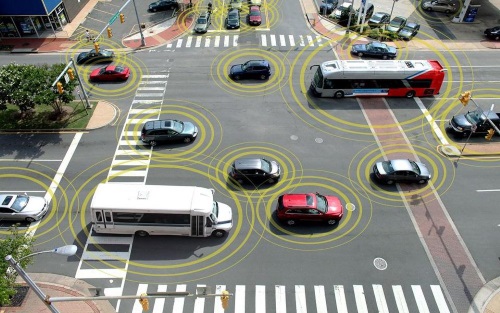Reducing the amount of wireless communication spectrum available to vehicle-to-everything or V2X technology “seriously undermines” efforts to reduce the number of annual traffic injuries and fatalities occurring on U.S. roadways while also short-circuiting efforts to reduce greenhouse gas emissions and improve transportation equity.
[Above image by NHTSA]
That is the argument the American Association of State Highway and Transportation Officials and the Intelligent Transportation Society of America made in a letter submitted as part of the record for a Senate Committee on Commerce, Science, and Transportation hearing on April 27.

“As you know, the 5.9 GHz spectrum band is currently reserved for intelligent transportation systems. Commonly referred to as V2X technologies, these systems allow vehicles to communicate with other vehicles [as well as] bicycle and pedestrian road users, infrastructure, and law enforcement to avoid crashes, enhance safety, improve transportation efficiency, and reduce air pollution,” the organizations argued in their letter.
They added that the National Highway Traffic Safety Administration predicts that the safety applications enabled by V2X technology could eliminate or mitigate the severity of up to 80 percent of non-impaired crashes, significantly reducing the nearly 37,000 lives lost and 3 million injuries that occur annually on U.S. roadways.

That is why AASHTO and ITS America said they continue to oppose the Federal Communication Commission rulemaking issued November 2020 that opened portions of the 5.9 GHz band to unlicensed uses, such as Wi-Fi. “This plan would not allow sufficient spectrum for V2X to function, threatening the significant safety benefits this technology provides,” they said in their letter.
[Editor’s note: In August 2019 the leaders of all 50 state departments of transportation, the District of Columbia and Puerto Rico signed a letter sent to the FCC to “continue our nation’s commitment to improving transportation safety” by reserving the 5.9 GHz wireless spectrum for transportation-only usage.]
Witnesses at the Senate hearing – held by the Subcommittee on Surface Transportation, Maritime, Freight, and Ports and entitled “Driving Innovation: the Future of Automotive Mobility, Safety, and Technology” – echoed AASHTO’s and ITS America’s position.

“The U.S. is taking a step back while our global competitors are moving forward with purpose. This is no more evident than in our approach to vehicle connectivity and communication,” noted John Bozzella, president & CEO for the Alliance for Automotive Innovation, in his written testimony.
He said the FCC’s decision to reallocate 45 megahertz of the 5.9 GHz spectrum band for use by “unlicensed devices” reduced by more than 50 percent the spectrum available for V2X technologies.
“This reduction in spectrum means that critical life-saving applications, including some that would support automated vehicles, are no longer possible in the U.S.,” Bozzella explained.

Additionally, the potential for “harmful interference” from adjacent communication channels threatens the ability of V2X to function in the remaining spectrum, argued Ann Wilson, senior vice president for the Motor & Equipment Manufacturers Association in her written testimony.
“Numerous technical assessments related to the FCC’s proposal, including preliminary assessments released by the USDOT [U.S. Department of Transportation], show that out-of-channel interference from unlicensed devices operating in adjacent bands would be likely to make the spectrum reserved for transportation safety communications unusable for such purposes,” she said. “This interference would delay or block safety-critical messages where split-second action is required to avert a crash.”

Finally, Reuben Sarkar – president and CEO of the American Center for Mobility – noted that communication technologies that enable V2X connectivity are still at a “nascent phase” of deployment. That is because the FCC’s 5.9 GHz spectrum made existing dedicated short-range communications or DSRC systems obsolete, he said – requiring new cellular CV2X technologies upgrades only now being deployed for purposes of testing.
Thus reducing the amount of spectrum available for new communications technologies to use could compromise the safe, timely, and successful deployment of new mobility solutions such as connected and autonomous vehicles of CAVs, Sarkar noted in his written testimony.
“If deployed properly, CAVs can greatly improve the safety, congestion, operational efficiency, and throughput of our transportation system, and further new streams of commerce and consumer experiences,” he said.



